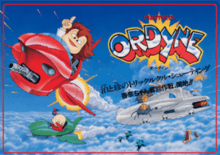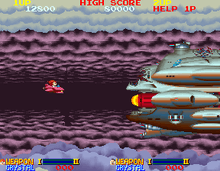Ordyne
Ordyne[lower-alpha 1] is a horizontal scrolling shooter arcade game, which was released by Namco in 1988 only in Japan. It runs on Namco System 2 hardware, and was ported to the TurboGrafx-16 in 1989, with releases in both Japan and North America. It features a cameo from Pac-Man, as the "Stock bomber shot" - and the arcade version was also included in Namco Museum Volume 4 for the Sony PlayStation. The TurboGrafx-16 version was released on the Wii's Virtual Console on May 7, 2007 in North America and on August 21, 2007 in Japan; it is officially described by Namco as a "comical action shooter". The shopkeeper, Miyuki Chan, also appeared in a taco shop in Mach Breakers in 1994 and in a flying loudspeaker-shaped shop in Project X Zone 2 in 2015.
| Ordyne | |
|---|---|
 Arcade promotional flyer | |
| Developer(s) | Namco |
| Publisher(s) | Namco |
| Composer(s) | Shinji Hosoe |
| Platform(s) | Arcade, TurboGrafx-16 |
| Release |
|
| Genre(s) | Horizontal-scrolling shooter |
| Mode(s) | Single-player, multiplayer |
| Cabinet | Upright |
| Arcade system | Namco System 2 |
Gameplay

The players take control of the genius scientist Yūichirō Tomari (泊裕一郎, Tomari Yūichirō) and his Chinese assistant Sunday Chin (サンデー珍, Sandē Chin) as they attempt to rescue Tomari's fiancée, Kana Aibara (相原香奈, Aibara Kana) from the evil Dr. Kubota (Dr. クボタ, Dokutā Kubota) and his army of robotic minions. The enemies all follow preset patterns, and killing a group of smaller ones or a larger one leaves crystals behind that can be collected and exchanged for special weapons, extra lives, and even more crystals at the "Kūchū IN" run by the blue-haired woman Miyuki-chan (みゆきちゃん, Miyuki Chan) and by firing out marbles at the extendable rotating target of the big white-handed robot Dream Co., Ltd. (夢有限会社, Yūme Yūgengaisha). This game has a total of seven rounds, and a boss is fought at the end of each one. One hit will kill Yūichirō and Sunday, unless either of them has the "Stock bomber shot", as Pac-Man and the shield he is generating will protect them from death for one non-projectile hit. They can either earn or buy extra lives. This game also features voice samples (in Japanese).
Reception
| Reception | ||||||||||||||||
|---|---|---|---|---|---|---|---|---|---|---|---|---|---|---|---|---|
| ||||||||||||||||
In Japan, Game Machine listed Ordyne on their November 1, 1988 issue as being the second most-successful table arcade unit of the year.[7]
Notes
References
- "オーダイン (PCE)". Famitsu (in Japanese). Kadokawa Corporation. Archived from the original on 31 July 2019. Retrieved 14 June 2020.
- M. Thomas, Lucas (7 May 2007). "Ordyne (Virtual Console) (Wii)". IGN. Archived from the original on 30 December 2007. Retrieved 14 June 2020.
- Nintendo Life Staff (8 May 2007). "Ordyne Review (TG-16)". Nintendo Life. Gamer Network. Archived from the original on 13 January 2019. Retrieved 14 June 2020.
- "10月号特別付録 PCエンジンオールカタログ'93" (in Japanese) (Volume 6, Number 10). Tokuma Shoten. PC Engine FAN. 1 October 1993. p. 72.
- "Videospiele - Ordyne" (in German). Markt & Technik. Power Play. February 1990. p. 66. Archived from the original on 22 April 2017. Retrieved 14 June 2020.
- "Closer Look - Ordyne" (June/July 1990). Larry Flynt Publications. TurboPlay. p. 22. Archived from the original on 5 January 2017. Retrieved 14 June 2020.
- "Game Machine's Best Hit Games 25 - テーブル型TVゲーム機 (Table Videos)". Game Machine (in Japanese). No. 343. Amusement Press. 1 November 1988. p. 25.